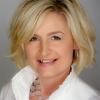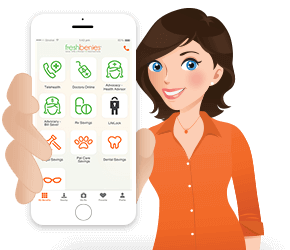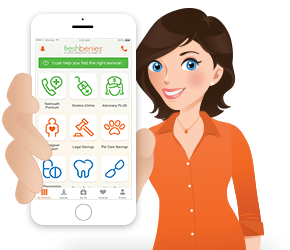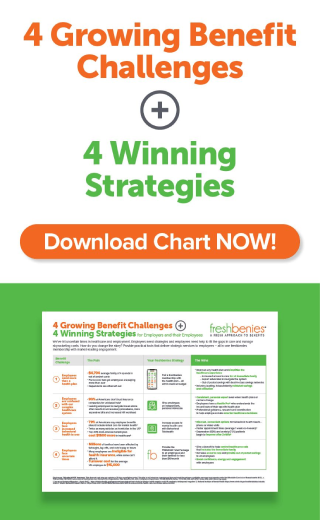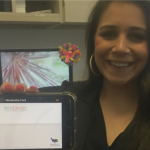HLTH CONFERENCE 2018: TOP 16 TAKEAWAYS

We just returned from the first-ever (and sold-out) HLTH Conference in Las Vegas. It was an impressive 4 days. The conference was touted as “the hottest, newest, largest and most important healthcare event creating a much-needed dialogue focused on disruptive innovation.”
But is it pronounced “health” or “H-L-T-H?” As the founder, Jon Weiner, explained: it’s just health without the vowels. The goal is to unburden the healthcare industry, so they unburdened the word by removing the superfluous letters.
Since we spend most of our conference time at events focused on employee benefits, our goal was to see what was happening in healthcare as a whole, and find new ideas to help our freshbenies members. The General Sessions were packed with great speakers and info. Then, there were 4 or 5 tracks each day with 40-minute breakout sessions. Most were moderated panels with industry insiders, experts, innovators on each topic.
Below are our top 16 takeaways from the conference…
1. Genomics is the future
It is believed that a genetic profile will become the starting point of a person’s health record and health care. Why? Because our genes dictate so many things about the best treatment for our bodies. Geisinger President & CEO, Dr. David Feinberg said, “I see a future when your doctor will order a mammogram, blood test, colonoscopy and genome sequencing.” A few examples:
• Anne Wojcicki, Co-Founder & CEO of 23andMe, noted that their genetic test can detect the presence of the BRCA1/2 gene mutation pointing to a propensity for breast cancer.
• Francis deSouza, President & CEO of Illumina, told the story of a pregnant mom who had a non-invasive prenatal genomics test that found her baby was at risk of being born without sweat glands. A certain protein was introduced at a specific week in the pregnancy and the baby was born 100% healthy.
2. Use of data
According to HLTH, “The human body offers billions of data points, fueling deep learning initiatives. What's relatively less plentiful at the moment are clear conclusions related to drug development, clinical decision making and patient care.” There are challenges in mining the data, but some players are moving beyond analysis to utilizing the information to learn about major healthcare issues and trends. TBD on exactly how that info will be used...
3. Data security & privacy
…which brought up questions about keeping data secure and private. According to HLTH, “With the emergence of virtual care and remote monitoring both clinicians and consumers share a growing concern about accuracy, privacy, security, data rights, consent, etc. related to health apps, wearables and other connected medical devices.”
In a somewhat heated session about AI, the discussion quickly turned to this topic. AI is using big data through Machine Learning to address some of the most challenging health problems. The technology is simply outpacing regulations and legislation protecting consumer data. The panel reiterated the importance of removing PHI from data, notes or identifying markers that would allow ANYONE to identify individuals. The fear is that insurers, employers, etc. will get a hold of this data and then make decisions about hiring, coverage, premiums, etc. We were reminded of a great statement made in the movie Jurassic Park where Jeff Goldblum’s character states, “…your scientists were so preoccupied with whether or not they could, that they didn’t stop to think if they should.”
Qualcomm Life, Samsung Electronics America and the American Medical Association announced a coalition to develop a joint set of industry guidelines and standards (think, food labels for health apps) to address the concerns (before the government takes it over).
4. Advances in technology
Not just technology for technology’s sake, but technology that can truly help. A few examples:
• Vinod Khosla, founder of Khosla Ventures, spoke about how medical schools should change their entrance tests to measure EQ instead of IQ because future Artificial Intelligence (AI) will beat the best human IQ.
• In the future, symptom-based diagnosis will be totally replaced with genetic diagnosis. Basically, diseases will be diagnosed BEFORE symptoms even present themselves.
• Dr. Chris Nicholson, Co-Founder & CEO of mPulse Mobile reiterated that doctors need to meet patients where they are, especially as we move into a different phase of technology with mobile, wearables and AI assistants. We need to understand patient pain points and determine how can we use new technologies to help.
• Health monitors, trackers and wearables continue to be a big trend with discussions centering around their ability to collect more and more data to help with a range of healthcare issues. Collin Lawlor, CEO of SleepScore Labs, spoke about how their tech is getting to the point that they can tell if you’ll have the flu 2 days prior to a diagnosis based on your sleep patterns.
5. Consumer driven healthcare
It’s a big deal even with this crowd! Many speakers believe the next big innovations in healthcare will be consumer driven because Americans are bearing more financial responsibility and there are more tools to help deliver solutions. One issue in moving it forward faster is…
6. Employee engagement
This was a big topic in many of the sessions – especially in the employer-focused track. Ben Slocum of WebMD Health Services noted that “the holy grail is employee engagement” while Henry Albrecht, CEO of Limeade, suggested we need to get beyond “engagement” to “connection.”
Benefits decision-makers at Fidelity, AT&T, Bank of America, and moderator Brian Marcotte from the National Business Group on Health sat on a panel to discuss how start-ups can work with large employers to launch new innovative ideas. They noted that employers are frustrated with one-off tools – as they’re trying to balance multiple “solutions,” it’s overwhelming to them and their employees. They don’t need another product – they need tools and solutions that engage employees.
7. Prescription costs
According to Doug Hirsch, CEO of GoodRx, 200 million prescriptions are left at the pharmacy counter every year because people can’t afford them. Unfortunately, most consumers don’t know the cost of their prescription before they make the trek to the store. This is a waste on many levels, since he said it costs a pharmacy an estimated $5 every time they fill a prescription. Also, 70% of GoodRx users have insurance, so the problem of high prescription costs is real and, besides improving health, there weren’t many insights into lowering them.
8. Walmart is pissed
Walmart’s VP of Health Transformation and Sr. Director of Healthcare Benefits started their presentation with this haunting 1991 video of Sam Walton expressing his concerns about healthcare in America. The duo made an announcement that they’re not putting up with the current state of healthcare and put providers on alert. They gave examples: when associates are directed to a center of excellence for a second opinion, 50% of spine surgery patients are told they don’t need surgery.
They discussed their challenges with the massive variation in care and approaches to ensure their associates get the highest value care in America. How? They’re opening primary care clinics, partnering with dental retail locations, creating a platform for employees to choose benefits, lowering prices on Rx and over-the-counter drugs, transparency tools for quality/price and networks that drive employees to the providers with best outcomes. They ended with, “Let’s get to a point when Americans aren’t angry with our healthcare system but are proud of it.”
9. Physician burnout
Research shows that 71% of physicians feel disengaged. Administrative tasks have increased 3000%+, so doctors spend 4-8 hours per week doing non-clinical tasks. Interoperability isn’t happening, so it’s not easy to get info from one provider to another. Jonathan Bush from AthenaHealth shared how a combination of tools, resources and latitude can allow physicians to break the stream of burnout and have a positive impact on patients and the industry.
10. Telehealth is still gaining momentum
According to HLTH, “No longer merely a communication vehicle or a smart toy, the mobile device is fast becoming the superhighway of the care industry. Connecting, monitoring, reporting, advising, prescribing...what can't this 3" by 6" device do?” Telehealth and mHealth were mentioned in multiple sessions. Jason Gorevic, CEO of Teladoc, mentioned how it’s becoming a platform for all types of care issues: second opinion services, behavioral health, dermatology, specialty pharmacy, etc. Former United States Representative, Patrick Kennedy, dropped by to announce the launch of a new provider-to-provider Telemedicine Accreditation Program Standards & Guide that will promote access to safe healthcare.
11. The future of medicines is digital
According to HLTH, “More than 80% of healthcare spending in the US is on chronic conditions mainly treated with oral drugs used by patients at home. But most people don’t take their drugs properly, resulting in over $500 billion in excess costs.” Digital Medicine is an up-and-coming pharmaceutical category that became FDA approved in 2017. A new drug called Abilify MyCite communicates with a mobile phone to tell the patient and their caregivers details about theirs experience. They partnered with patients who were bi-polar or had schizophrenia to learn about their lives. Did the patient take their drug? Did it get digested? Did it work? How has the drug impacted the patient’s life? Should a caretaker intervene?
12. Behavioral health help
Millions of Americans are affected by mental health conditions every year. The National Alliance on Mental Illness estimated the annual cost of unaddressed mental conditions to be $100 billion just in lost productivity. Many speakers and employers spoke of the need for cost-effective behavioral health solutions and access to this type of care.
13. Lifestyle Medicine
We heard from Dr. Dean Ornish, Founder & President of Preventative Medicine Research Institute. According to HLTH, “His research has proven for the first time that lifestyle medicine can reverse the progression of the most common chronic diseases.” Our bodies have an amazing ability to heal themselves. But, sometimes we don’t let it happen because we jump to medicine so quickly. Medicare and most major insurance companies are now covering his program for reversing heart disease.
14. CVS as a holistic caregiver
Did you know that 75% of the US population is within 5 miles of a CVS? They’re expanding their service model to include primary care, digital engagement, face-to-face care, optometry, chronic disease management and more. Look to this corner drug store to become a more holistic caregiver. They’re doubling down on healthcare for their local communities.
15. The last mile
Lyft and Uber are continuing to disrupt with a focus on healthcare. It’s estimated that 3.6 million doctor appointments are missed each year due to patients not having transportation. Some providers have resources for their patients, but they typically require 48-hour notice. In March, Uber launched a HIPAA compliant product that allows providers to easily schedule rides for patients. Doctors are already reporting a reduction in missed appointments - the hope is that this will lead to better outcomes. Uber is now delivering flu shots and considering additional services such as fresh food and Rx delivery.
16. Well-being community programs
Multiple speakers discussed the idea of improving well-being within communities with high-tech AND high-touch solutions. The Healthy Nevada Project enrolled 1 in 10 northern Nevadans into a program that combines genetic, clinical and environmental data to improve health from the individual level to the state. They showed stories of multiple people who had changed to healthy behaviors as a result of the program. Jeff Arnold, Chairman & CEO of Sharecare and Dan Buettner, National Geographic Fellow and New York Times bestselling author, discussed how they are partnering to create “Blue Zones” across the globe. Blue Zones are rare hotspots around the world where conditions like food, community, activity, stress levels, eating habits, etc. are optimal for living a longer life. They claim the average person’s life expectancy could increase by 10-12 years by adopting a Blue Zones lifestyle.
Our freshbenies team goal was to look for new and innovative ways to help our members control their healthcare dime, time and peace of mind. We consider it a success because we came out of the conference with a nice list of ideas to pursue.
Now it’s your turn! Did you go to the conference? What were your learnings? What’s on your list of ideas to pursue? Make a comment below or drop me a note at heidi@freshbenies.com!



